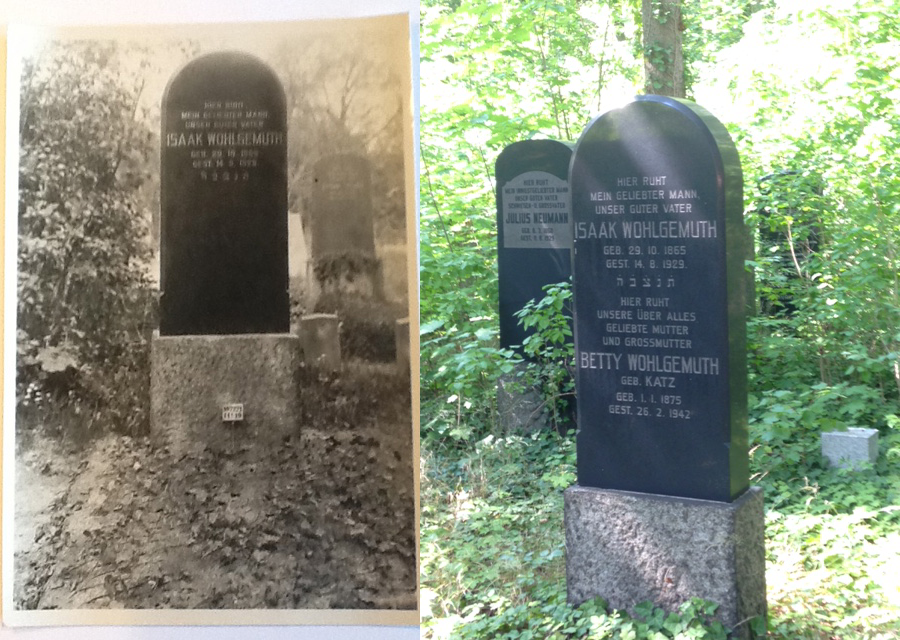Interpreting the Wohlgemuth headstone
On the right is the photo Joanne snapped yesterday at Weissensee Cemetery in Berlin. It is the headstone of Helga's grandparents Isaak and Betty Wohlgemuth.
Note Betty's death date of February 26, 1942. Also note her maiden name Katz and birth date, which match up with newly available records on Ancestry.com that reveal the Katz family history in the town of Kolberg, West Prussia, and the Wohlgemuth family in Stargardt, West Prussia.
The photo at left is the one carried by Elly Ringel, the daughter of Isaak and Betty, on her journey to America, and thus was made before late August or early September of 1938 when Elly and Helga left Berlin. It shows the same headstone with Isaak's inscription (he died in 1929) but obviously is without the inscription for Betty (since she was still living in 1938).
Until yesterday, we had not known Betty's fate after 1940, when we know she was in touch with Elly while she and Helga were refugees in France and Betty sent them the money that enabled them to escape Europe. There had been much speculation among the Ruby siblings that Betty had suffered deportation to the camps, perhaps Auschwitz, as did tens of thousands of Jews from Berlin between October 1941 and early 1945.
The fact that Betty was apparently laid to rest at Weissensee in February 1942 strongly suggests this is not the case. The surprising history of Weissensee is that the cemeter continued in operation throughout the war. According to an article I read yesterday, there were more than 3200 burials (almost 10 per day) during 1942. This dropped to 931 and 244 in 1943 and 1944.
The history suggests that the Nazis allowed Weissensee and also a Berlin Jewish hospital to remain in operation throughout the worst years of Jewish persecution, probably as a public relations ploy to portray the regime as sympathetic to the plight of the local Jewish population. In reality, they began a systematic roundup and deportation of Berlin Jews in October 1941.
Betty Wohlgemuth would have been 66 years old at the time. Joanne believes she was living in an upstairs apartment at the Schlüterstrasse 12 address, though I want to review her evidence for that. As an older, female, widowed Jew with proven German citizenship (by virtue of her father's birth in West Prussia) she was not included in the early transports of Berlin Jews during 1941.
I was asked yesterday if Betty could have died in a camp and the inscription made later, perhaps even with some ashes interred. While it is true that ashes of some concentration camp victims are interred at Weissensee, I understand they were in a mass grave that was destroyed by bombardments in the last days of the war. (While the historic cemetery was thankfully mostly undamaged, one section sustained heavy damage.)
If Betty had been killed in a camp and later a stone was inscribed, I believe there would have been some reference to the place and manner of her death. Since there is not, the more logical explanation is that she died in Berlin and was buried by the still-functioning Jewish community.
At this point, we don't know how she died at age 67 in February 1942. Nor do we yet know who arranged and paid for the headstone inscription. Her age and circumstances certainly allow for any number of natural causes. Another possibility is suicide.
The article I referenced above says that 811 of the burials in 1942 were suicides, up from 254 in 1941. Presumably the 300 percent increase can be explained by the new deportation orders that went into effect in late 1941. Could our great-grandmother have been among that statistic, or did she die of a natural cause? There may be more we can find out.
One more matter to consider here is the cause of our misinformation. Several family members have visited the cemetery before and not seen the Wohlgemuth headstone. This is because the main focus of their visits was the Hermann Ringel headstone in a different section of the cemetery. Joanne said yesterday that she doesn't think she saw the Wohlgemuth grave on her earlier visit.
This explains our recent ignorance of the Betty Katz data on the headstone. I am wondering now what Elly and Helga knew about Betty's fate. Was Elly ever able to communicate with her mother after she and Helga arrived in America in April 1941? Did she learn of her mother's death at the time or at any time later? I don't believe Elly was ever able to visit the grave during her lifetime (she died in 1981). Though she traveled to Germany in the 60s and 70s, Weissensee was in East Berlin and she would probably not have obtained permission to go there. So she probably never saw the headstone. As to whether she could have been informed of Betty's death by the remaining Jewish community, that is an open question.
If Elly did know what had happened to Betty, then Helga would have known too. Helga traveled to Berlin in the post-wall period and I'm pretty sure she visited the cemetery at the time. In her interviews with Walter near the end of her life, she gave the impression that she believed Betty died in a camp.
So we are left uncertain for the moment about whether Elly and/or Helga knew of Betty's true fate, and thus whether our recent finds are true discoveries or perhaps a rediscovery of forgotten family history. That headstone has been standing there with Betty's information since 1942 but our generation just learned of it in August 2016.
Better late than never.

